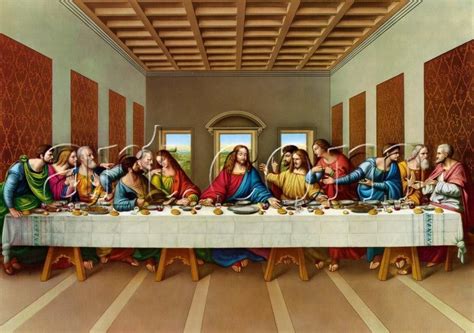The iconic depiction of the Last Supper, one of the most revered and recognizable works of art in history, was meticulously crafted by the hand of the Italian master, Leonardo da Vinci.

Leonardo’s Masterpiece: The Last Supper
Leonardo da Vinci, renowned for his exceptional skills in painting, architecture, and engineering, dedicated over a decade to the creation of the Last Supper. This monumental fresco adorns the refectory wall of the Santa Maria delle Grazie in Milan, Italy.
The Last Supper portrays the pivotal moment in Christian history when Jesus Christ shares his final meal with his disciples before his crucifixion. Leonardo’s genius is evident in the intricate details and symbolism woven into the composition. Each apostle is portrayed with distinct expressions and gestures, conveying their varying reactions to Jesus’ announcement of his impending betrayal.
The Technique and Materials
Leonardo da Vinci’s innovative approach to art extended to the techniques he employed in the creation of the Last Supper. Rather than using traditional fresco methods, he experimented with a new technique known as “tempera grassa.” This technique involved mixing oil paint with tempera, resulting in a more durable and vibrant finish.
The Last Supper’s exceptional level of detail is a testament to Leonardo’s meticulous nature. It is believed that he spent countless hours studying human anatomy and facial expressions to accurately capture the emotions of the apostles.
The Symbolism and Legacy
Beyond its artistic brilliance, the Last Supper is imbued with profound symbolism and theological significance. The central figure of Jesus Christ dominates the composition, his body forming a triangle, a symbol of the Trinity. The apostles are arranged in groups of three, representing the Holy Trinity.
The meal depicted in the fresco is symbolic of the Eucharist, the Christian sacrament of bread and wine. The table and chalice at the center of the composition evoke this sacred ceremony.
The Last Supper’s enduring legacy has cemented its place as one of the most influential works of art in Western civilization. It has been the subject of countless reproductions, adaptations, and interpretations over the centuries.
The Last Supper: A Journey Through Time
The Last Supper has endured the passage of time with remarkable resilience. However, it has not remained unscathed. Over the centuries, it has faced various threats, including damage from moisture and alterations made by subsequent restorers.
In the 17th century, a doorway was cut into the lower portion of the fresco, altering its original composition. It was also subjected to several restoration attempts, which have had varying degrees of success.
Despite these challenges, the Last Supper’s significance and impact remain undiminished. It continues to captivate visitors from around the world, serving as a testament to Leonardo da Vinci’s genius and the enduring power of art.
The Art Market and the Last Supper
Leonardo da Vinci’s Last Supper is not for sale and has never been sold. It is a priceless masterpiece that is permanently housed in the Santa Maria delle Grazie in Milan, Italy.
The art market for Leonardo da Vinci’s works is highly competitive, with his paintings fetching astronomical prices at auction. In 2017, his masterpiece “Salvator Mundi” was sold at auction for a record-breaking $450.3 million.
Table 1: Key Dimensions of the Last Supper
| Dimension | Measurement |
|---|---|
| Height | 15 feet (4.6 meters) |
| Width | 29 feet (8.8 meters) |
| Surface Area | 435 square feet (40.4 square meters) |
Table 2: Timeline of the Last Supper
| Event | Date |
|---|---|
| Leonardo da Vinci begins painting | 1495 |
| Leonardo da Vinci completes the Last Supper | 1498 |
| Damage from moisture | 16th century |
| Doorway cut into the fresco | 17th century |
| First restoration | 1726 |
| Second restoration | 1901-1908 |
| Third restoration | 1954-1982 |
| Fourth restoration | 1999-2000 |
Table 3: Notable Restorations of the Last Supper
| Restoration | Dates |
|---|---|
| First Restoration | 1726 |
| Second Restoration | 1901-1908 |
| Third Restoration | 1954-1982 |
| Fourth Restoration | 1999-2000 |
Table 4: The Last Supper in Popular Culture
| Reference | Type |
|---|---|
| The Da Vinci Code | Novel |
| The Last Supper | Television series |
| The Last Temptation of Christ | Film |
Conclusion
Leonardo da Vinci’s The Last Supper remains an enduring masterpiece, capturing the imagination of art enthusiasts worldwide. Its profound symbolism, meticulous execution, and enduring legacy have solidified its place as a timeless work. The fresco continues to inspire, provoke thought, and connect viewers with the pivotal moment it depicts.
